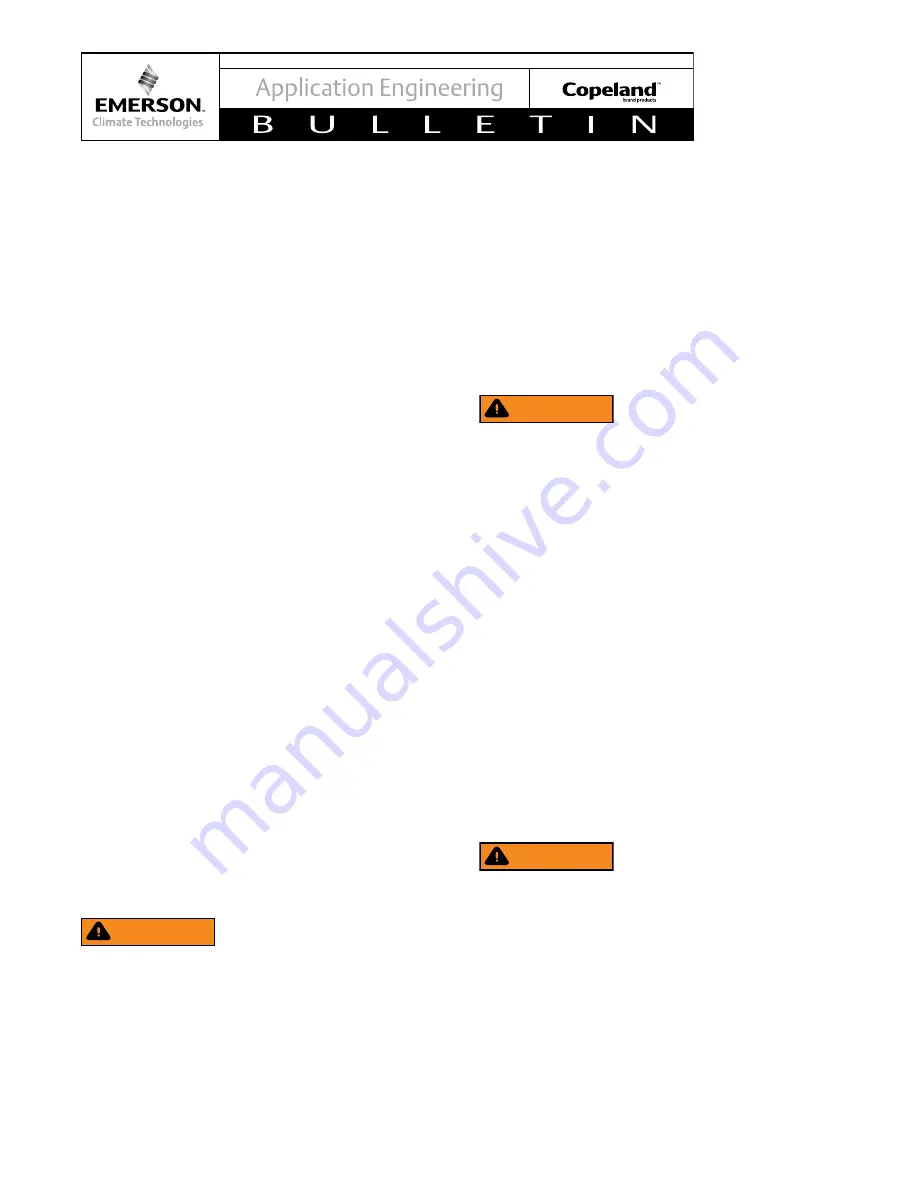
13
© 2016 Emerson Climate Technologies, Inc.
AE4-1303 R15
be removed first before pulling the suction connection
plug to allow the dry air pressure inside the compressor
to escape. Pulling the plugs in this sequence prevents
oil mist from coating the suction tube making brazing
difficult.
The copper coated steel suction tube should
be cleaned before brazing (see Figure 6).
No object
(e.g. a swaging tool) should be inserted deeper than
two inches (51 mm) into the suction tube, or it might
damage the suction screen and motor.
Mounting
The tested rubber mounting grommet and sleeve
kit is listed in
Table 4
. This drawing can be found at
www.emersonclimate.com
under the Miscellaneous
tab in the
Online Product Information (OPI)
. For
applications such as tandems or mobile applications,
the compressor should be hard mounted directly
to the rails or base to relieve stress on the tubing.
An additional bellyband brace must be used with
mobile applications to keep compressor movement
to a minimum and relieve stress on both the feet
and the tubing. The steel spacer developed for such
applications is the
027-0385-00
.
Many OEM customers buy the mounting parts directly
from the supplier, but Emerson's grommet design and
durometer recommendations should be followed for
best vibration reduction through the mounting feet.
Suction and Discharge Fittings
These compressors are available with stub tube or
Rotalock connections. The stub tube version has
copper-plated steel suction and discharge fittings.
These fittings are far more rugged than copper fittings
used on other compressors. Due to the different
thermal properties of steel and copper, brazing
procedures may have to be changed from those
commonly used. See
Figure 6
for assembly line and
field brazing procedures and
Table 6
for Rotalock
torque values.
Assembly Line Brazing Procedure
WARNING
Personal safety equipment must be used during
brazing operation. Heat shields should be used to
prevent overheating or burning nearby temperature
sensitive parts. Fire extinguishing equipment
should be accessible in the event of a fire.
Figure 6
discusses the proper procedures for brazing
the suction and discharge lines to a scroll compressor.
NOTICE
It is important to flow nitrogen through the
system while brazing all joints during the system
assembly process.
Nitrogen displaces the air and
prevents the formation of copper oxides in the system.
If allowed to form, the copper oxide flakes can later
be swept through the system and block screens such
as those protecting capillary tubes, thermal expansion
valves, and accumulator oil return holes. The blockage
– whether it is of oil or refrigerant – is capable of doing
damage resulting in compressor failure.
Unbrazing System Components
WARNING
Before attempting to braze, it is important to recover
all refrigerant from both the high and low side of
the system.
If the refrigerant charge is removed from a scroll-
equipped unit by evacuating the high side only, it is
possible for the scrolls to seal, preventing pressure
equalization through the compressor. This may leave
the low side shell and suction line tubing pressurized.
If a brazing torch is then applied to the low side while
the low side shell and suction line contain pressure, the
pressurized refrigerant and oil mixture could ignite when
it escapes and contacts the brazing flame.
CAUTION!
It is important to check both the high pressure
and low pressure sides with manifold gauges
before unbrazing.
Instructions should be provided
in appropriate product literature and assembly (line
repair) areas. If compressor removal is required, the
compressor should be cut out of system rather than
unbrazed. See
Figure 6
for the proper compressor
removal procedure.
Pressure Testing
WARNING
Never pressurize the compressor to more than
400 psig (27.6 bar) for ZR*KCE and 475 psig (32.8
bar) for ZP*KCE compressors. Never pressurize
the compressor from a nitrogen cylinder or other
pressure source without an appropriately sized
pressure regulating and relief valve.
Higher pressure may result in permanent deformation of
the compressor shell and possibly cause misalignment
or bottom cover distortion.














































